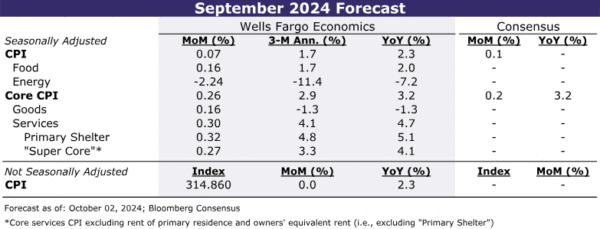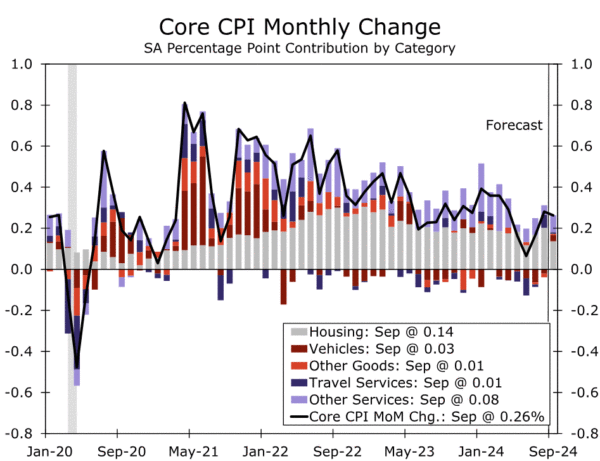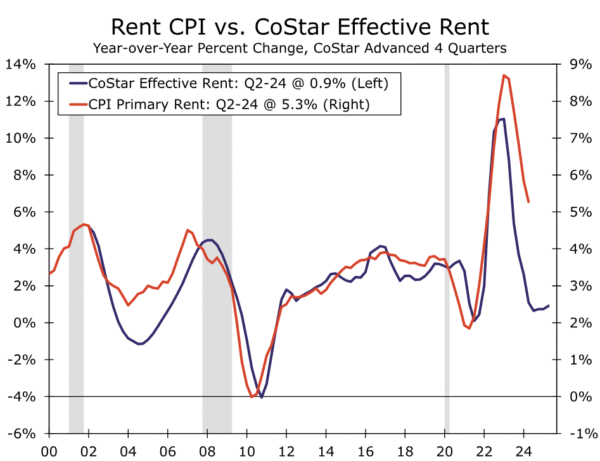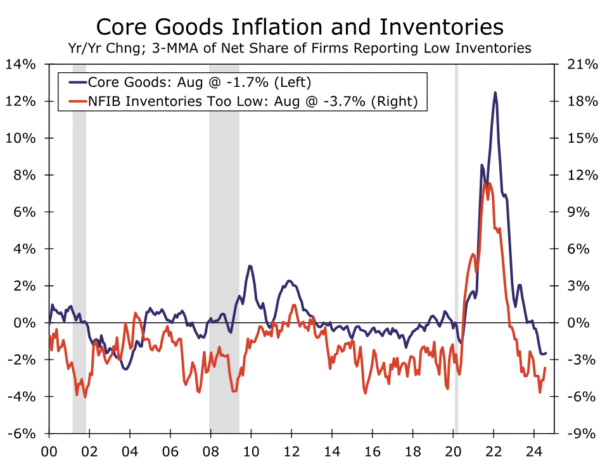Summary
The overall progress in reining in decades-high inflation should be on display with the September CPI report. We look for the headline to advance 0.1%, which would bring the year-over-year rate down to 2.3% and point to headline PCE rising 2.0%—directly on the FOMC’s target in what will be the last read on inflation before the Committee’s November 7 meeting.
Reducing core inflation remains more of a grind. We estimate the CPI excluding food and energy will post another “low” 0.3% increase (0.26% unrounded) in September, which would lead the year-over-year rate to slip back to 3.2%. Although we expect a similarly-sized gain as in August, the drivers are likely to be different. Core goods prices look poised to take a temporary breather from the deflationary trend we believe is still underway, while core services inflation should moderate amid smaller gains in shelter and travel prices.
Looking ahead, the strike among East and Gulf Coast dockworkers presents a near-term upside risk to goods inflation. For now, however, we expect minimal effects on consumer goods prices due to the improved picture for retail inventories and softer demand environment compared to a few years ago. Services inflation should recede further in the months ahead as the cooler rental market feeds through to official measures of shelter inflation and the jobs market softens. We look for the monthly pace of core CPI to downshift to around 0.20% through the remaining months of the year and, of more focus for the FOMC, for the 12-month change in core PCE inflation to ease to around 2.25% by this time next year.
Headline CPI: Now That’s More Like It
September’s CPI report should indicate that inflation slowly continues to recede. The ongoing moderation in price growth should be most evident in a tame headline gain. We look for the Consumer Price Index to advance just 0.1%. If realized, that would drive the year-over-year rate down to 2.3% and point to headline PCE rising 2.0%—directly on the FOMC’s target in what will be the last read on inflation before the Committee’s November 7 meeting.
The pullback in gasoline prices over the past year has been one key factor in driving the headline lower. We estimate energy goods prices fell a little more than 4% in September and 15% since this time last year. Food inflation has also quieted down amid tamer commodity prices, more price-sensitive shoppers and slower wage growth at restaurants and grocery stores (Figure 1). We look for prices for food at home and away from home to have advanced 0.1% and 0.3%, respectively, in September, which would result in the year-over-year pace of the overall food index slipping to 2.0% from 3.7% last September and more than 11% at its recent peak.
Core CPI: Goods and Services Reverse Roles in September
Reducing core inflation, however, remains more of a grind. We expect another monthly increase in the core index that teeters on the edge of a 0.2% or 0.3% gain. While our unrounded estimate of 0.26% is little different from August’s 0.28% increase, underneath the surface, we look for a different set of drivers (Figure 2). Specifically, we look for core goods prices to swing from a 0.2% monthly decline to a 0.2% monthly increase amid a pickup in used auto prices (+1.5%) and less favorable seasonal factors. These factors should be temporary, however, leading us to expect a resumption of goods deflation in the final months of this year.
Core services, on the other hand, should quiet down a little in September; we estimate a 0.3% gain after a 0.4% increase in August. At the risk of seeming like Charlie Brown trying to kick Lucy’s football, we still see signs that primary shelter inflation will slow further, and that the nearly 6% annualized monthly rate recorded in August is not reflective of the underlying trend. The apartment vacancy rate according to CoStar through Q2 has remained at its highest level since 2009, with apartment rent growth running below its pre-COVID pace according to a litany of measures (e.g., CoStar, Zillow and the BLS’s New Tenant Rent Index, Figure 3). While low affordability in the purchase market is keeping single-family rent growth more or less in line with its 2018-2019 clip, the CPI for owners’ equivalent rent, at 5.4% year-over-year, remains roughly two percentage points higher than its pre-pandemic pace. After increasing 0.5% in August, we estimate primary shelter rose 0.3% in September. Core services ex-housing is also likely to come in a little lighter in September, helped by a more modest gain in airfares and further easing in motor vehicle insurance inflation.
Upward Pressure on Prices Continues to Generally Ease
Despite the recent pace of core CPI having picked up since mid summer—we estimate a three-month annualized rate of 2.9% in September compared to 1.6% in July—the intact downward trend should be evident by the year-over-year rate edging back down to 3.2%. Moreover, as we look ahead, inflation pressures continue to generally dissipate. Admittedly, the East and Gulf Coast dockworkers strike presents a near-term challenge to furthering goods deflation. For now, we expect minimal effects on consumer goods prices due to the better inventory picture and softer demand environment compared to a few years ago, although a prolonged dispute would change our view (Figure 4). Services categories remain the laggard in terms of inflation settling back down, but we continue to expect a further moderation over the coming quarters. Not only does softer shelter inflation still seem to be just a matter of time, but service providers, such as insurers and airlines, should benefit from more stable/lower prices for goods inputs (e.g., vehicles and oil prices). Meantime, fewer quits as the job market cools and the pickup in productivity growth are reducing inflationary pressure from the jobs market—dynamics that will help limit goods and services inflation alike.
We look for the 12-month change in headline CPI to remain around 2.0-2.5% over the next year, which should translate into the PCE deflator hovering right around the Fed’s 2% target (Figure 5). Excluding food and energy, price growth should continue to recede, as further services disinflation more than offsets less-dramatic goods deflation. We look for the year-over-year pace of core CPI inflation to slow to around 2.5% by the third quarter of next year, with the gap between the core CPI and core PCE narrowing near its historic 0.3 percentage point average.


















